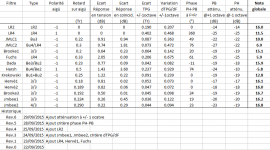It is quite easy to use the approximation of a subtractive crossover with a widerange driver combined with a well-behaved woofer (even better in MTM). The lower the order the easier. "2nd order" HP with "1st order" LP is the easiest because it gives the least overlap and the lowest bump in the "derived" path.
For everything else the use of other crossover topologies is advised.
Regards
Charles
Is there a practical implementation of this design and wouldn't the inevitable woofer BSC affect phase response to the point it couldn't be corrected without siginificant offset of the HF driver?
I've always wondered whether you could use an MTM configuration to benefit your proposed topology.
The B&O filler driver method does have its merits practically but finding a suitable filler driver is difficult in the real world.
My personal goal would be trying to put together a close to phase correct 3 way system which could offer higher SPL output, which out of obvious reasons would be difficult to achieve due to the shallow filter slopes which are needed.
That's interesting.
I re-configured my Manger 109 xovers with 6dB LP / 12dB HP @ 400 Hz...
I never measured step response, but they sounded much more "together" than with the factory spec Manger xover. I just messed with it all until piano and percussive instruments sounded right to me.
I never realized that those two types of filter slopes could combine that correctly.
I re-configured my Manger 109 xovers with 6dB LP / 12dB HP @ 400 Hz...
I never measured step response, but they sounded much more "together" than with the factory spec Manger xover. I just messed with it all until piano and percussive instruments sounded right to me.
I never realized that those two types of filter slopes could combine that correctly.
The frequency response curves for the asymmetric crossovers make me think of the
filler design but with the filler output provided by either the woofer or tweeter.
filler design but with the filler output provided by either the woofer or tweeter.
Yes, this is actually what it does. It adds the filler signal to either the low- or highpass.
It is possible to get higher orders asymmetric like 2nd/3rd or even more with these. And also symmetric versions are possible. But these can only be done actively and the slopes get very shallow around the crossover frequency and the humps are also getting higher.
Regards
Charles
It is possible to get higher orders asymmetric like 2nd/3rd or even more with these. And also symmetric versions are possible. But these can only be done actively and the slopes get very shallow around the crossover frequency and the humps are also getting higher.
Regards
Charles
To add the documentation of this thread, google translation is your ami : 5.3 Comment filtrer les haut-parleurs ? - francis.audio
it talks also on the quasi perfect transcient filters too and there is at the end an interesting screen board that sort out qualities and defaults vis à vis of more classic filters like a second order...very interrestinginformative. We saw a Harsch is not well rated and ask the most horizontal spacing which is a problem passive. Of course the only one where the drivers are in positive polarity (while I like also what is doing Proac with all the two ways where both drivers see their signal coming to the negative pole of the drivers, close logic I assume ?
Some works of <Jean-Marie >Le Cléach on the quasi transcient perfect filter in 3 ways that can be more handy than the Duelend which asks very linear drivers which is not easy - see the excellent work the fun guys at HTGuide are doing for illustration about Duelund filters type-
I have found also this link is explaining well for basic people like I am , the difference between group delay, phase and le savoir faire in the filter related to the "time" aligement of the driver in the filter.

it talks also on the quasi perfect transcient filters too and there is at the end an interesting screen board that sort out qualities and defaults vis à vis of more classic filters like a second order...very interrestinginformative. We saw a Harsch is not well rated and ask the most horizontal spacing which is a problem passive. Of course the only one where the drivers are in positive polarity (while I like also what is doing Proac with all the two ways where both drivers see their signal coming to the negative pole of the drivers, close logic I assume ?
Some works of <Jean-Marie >Le Cléach on the quasi transcient perfect filter in 3 ways that can be more handy than the Duelend which asks very linear drivers which is not easy - see the excellent work the fun guys at HTGuide are doing for illustration about Duelund filters type-
I have found also this link is explaining well for basic people like I am , the difference between group delay, phase and le savoir faire in the filter related to the "time" aligement of the driver in the filter.

Attachments
Last edited:
- Home
- Loudspeakers
- Multi-Way
- PASSIVE Linear Phase (Quasi Transient Perfect) XO s
